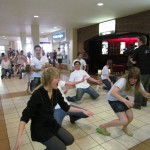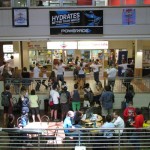The Tech Fest is an initiative of the Student Technology Programme (STP), whose objective it is to offer affordable tablets and laptops for purchase to all students of public universities across South Africa.
Students and staff had the opportunity to get some valuable information on the technology on offer via STP and could also try out some of the products.
The Maties Dance Society entertained the crowd over lunchtime and the names of the winners of the October Tech Fest competition were drawn. Watch video here.
- Visit www.sun.ac.za/ithub or www.stp.ac.za for more information on the technology on display and the Student Technology Programme.
- Maties Dance Society entertains the audience
- Flashmob!
- And the winner is ….
- Winners Nsovo Tonny Mathebula, Andrea Kruger, Lourens Coetzee, Marius Snyman
ʼn Tegnologiefees met verskeie pryse, groot afslag en die geleentheid om die nuutste tegnologie uit te toets en daarmee te speel, is Dinsdag 22 Oktober in die Neelsie gehou.
Die Tegnologiefees was ʼn inisiatief van die Studente Tegnologieprogram (STP) wie se doel dit is om bekostigbare tablette en skootrekenaars te verskaf aan alle studente verbonde aan openbare universiteite in Suid-Afrika.
Personeel en studente kon nie net waardevolle inligting oor die tegnologie wat die program bied kry nie, maar kon dit ook uittoets en daarmee speel. Daar was verskeie pryse op die spel en afslag is aangebied op heelwat van die produkte wat uitgestal is.
Die Maties-dansvereniging het vir die vermaak gesorg oor middagete en die name van die wenners van die October Tech Fest-kompetisie is getrek. Kyk video hier.
- Lees meer oor die tegnologie wat uitgestal en die Studente Tegnologieprogram by www.sun.ac.za/ithub of www.stp.ac.za.
- Maties Dance Society entertains the audience
- Flashmob!
- And the winner is ….
- Winners Nsovo Tonny Mathebula, Andrea Kruger, Lourens Coetzee, Marius Snyman


















